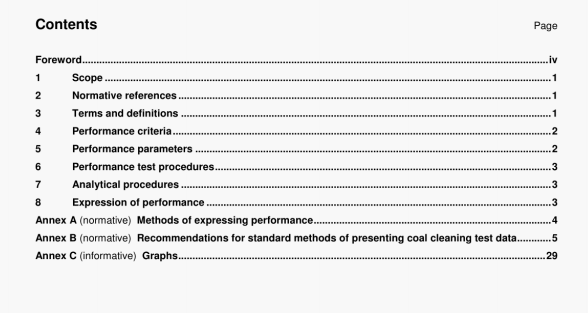ISO 923 pdf download – Coal cleaning equipment- Performance evaluation.
Although for Method A the formulae are entical for diaOrams 2 and 3, in the latter case there Is no sharp dividing line between the first and second cuts. The first (h.gh-denslty) cut separates the reject R from the combmation of the cleaned coal C and middlings M. and it is this combination that becomes the teed to the second stage of the separation.
Method A enables the efficiency of each of the two separations to be studied individually, because only the material actually admitted to the separation is included in the calculation. This is of advantage when considering the performance of each machine or stage in the separation process.
Method B does not show up so emphatically the actual performance of the second machine o stage, but by ref ernng each separation back to the reconstituted raw teed it facilitates comparisons of the efficiency of the whole separation process in terms of the results on the original raw coaL (The sequence of operations included in this complete process may include steps not shown ii cagrams 1 to 3, for example crushing of the midings and ito recircutation to the feed, which is common in jig washing and may also occur in dense-medium separatior’i)
It Is essential, whenever the efficiency of a three-prockict separation is expressed (for example, in descr4ions of plant and efficiency statements and guarantees), that it be clearly stated which of these two bases has been used for the calculation. To facilitate this, it ie proposed that Method A be described as the equçment performance basis, and Method B as the coal performance basis.
Tables B.1 to B.10 for the three-product separations are drawn up on the coal performance basis. When calculations are made on the equipment performance basis, it is recommended that two-product tables be used (one for each stage). It is possible, however, to deduce the results Iron, the tivee-product table; thus, partition coefficients for the second cut would be calculated on the equipment performance basis as follows:
a) for diagram 1 (see Figure B.1 in clause 8.2). column (12) would be calculated from (7)1(9) instead of (7)1(10) in Table B.7;
The relative densities of 1770 and 1,835 correspond respectively to 96,6 % and 96,7 % for the amounts of correctly placed material.
8.3.5 Correctly placed (and misplaced) material — Low-density cut (see Figure C.4)
The same considerations apply as for the high-density cut, the amounts of misp’aced materials in each product
being plotted from columns (23) and (24) and the total from column (25) in Table B.8. The equal-errors cut-point
(density) and the partition densities are 1,400 and 1,505 and the amounts of correctly placed material 89.9 % and
91,0 % respectively.
The curves in Figures Ci to C.4 have been drawn on the coal performance basis, all yields being expressed as a percentage of the reconstituted raw coal. On the equipment performance basis, the washing operation being regarded as two distinct two-product separations. the construction of the curves follows exactly the same method as for any two-product separation and presents no difficulties. The curves that apply to the high-density cut (Figure Cl: lower curve; Figure C.2: point X; Figure C.3: upper curve) are identical for both bases.
ISO 923 pdf download – Coal cleaning equipment- Performance evaluation
